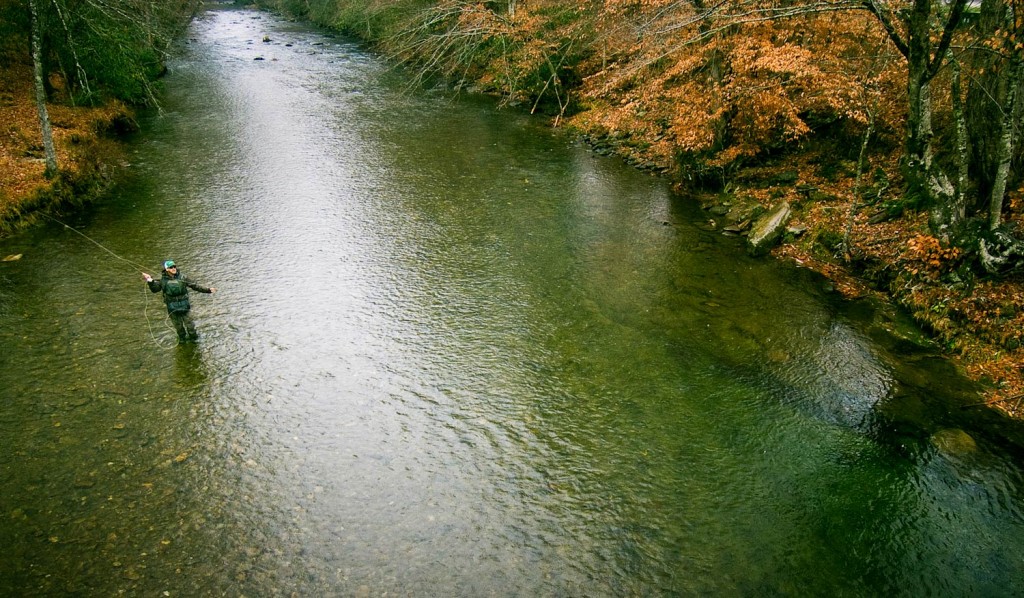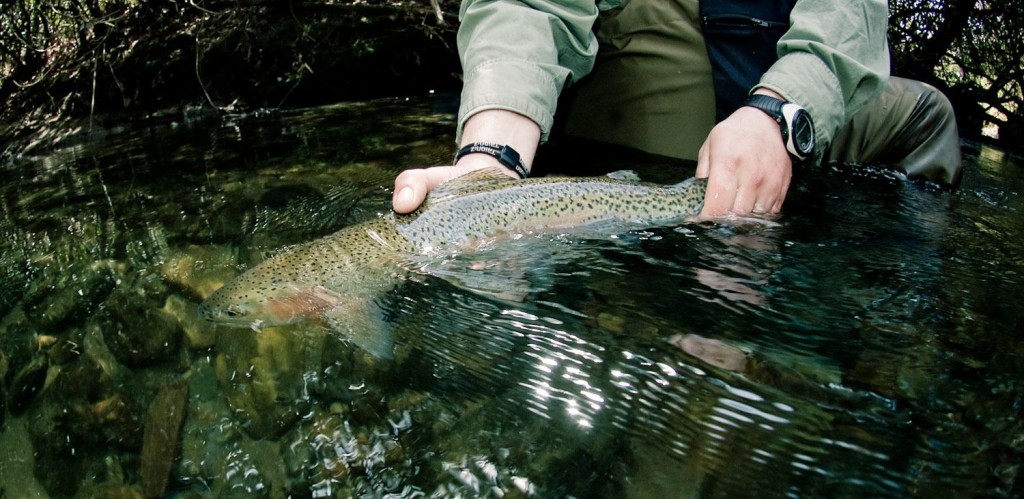Countless fly fishing articles have been written about matching the hatch, setting up your rig correctly for the water your fishing, and how to cast tight loops.
It’s very true these are all areas in your fly fishing game you should always have covered, but what about angler positioning? Why aren’t we talking more about how important angler positioning is for fly fishing success. Have you ever wondered why there are trout fishermen out there that can’t cast forty feet, yet when they’re on the water fishing, they literally mop up every fish like a vacuum. There’s a simple reason for this folks. Great fisherman, that suck at fly casting, usually figure out really quick how important angler positioning is for ensuring they get presentations that produce hookups.
Listen up all you competition casters out there. I’m happy you can reach the far end of the casting pond with your fly. It’s not easy shooting fifteen feet of backing out the end of your fly rod. That’s impressive, but if that’s how you choose to spend your time trout fishing, you’re probably going to catch few fish. Oh, and remember that guy that you just laughed off the casting pond with his pathetic forty foot cast? He’s going to out fish you nine times out of ten, because he’s figured out, presentation trumps distance casting.
Forgive me if I came across a little tart there. Sometimes it’s helpful for driving the point home with my target audience. The fact is, I consistently find fly fishermen of all skill levels struggling with angler positioning. Most have problems determining where they should position themselves when they first approach a stretch of water. The problem lies with them not first thinking about where they need to be standing, so they can make their best cast and presentation. Instead, they’re thinking, “I”m not going to waist my time wading upstream, if I can reach that spot with my fly where I”m standing right here”. This usually doesn’t pan out very well for them. Two scenarios usually play out with this fishing approach. The first scenario has the angler landing the fly short, right on top of the pod of fish, very often resulting in alerting or spooking the fish. The second scenario, the angler does manage to get the fly where it needs to be, but because they’ve chosen to stand in the wrong spot, they have conflicting currents that compromises their drag free drift. In both cases, anglers that ignore the importance of angler position, remain fish-less.
Below are 3 tips for better angler positioning.
1. Examine your fishing spot and determine where the best stretch of water, or honey hole is located.
Once you’ve figured out where the honey hole is, and where the trout should be stationed, you should position yourself perpendicularly across from it. Sometimes slightly downstream of perpendicular is best. Doing this, you’ll be able to present your flies upstream of the fish, and you’ll be in good position for line management, resulting in and a drag-free drift through the entire stretch of prime water.
2. Try to position yourself when possible in the same current speed you’ll be fishing.
Conflicting currents of different speeds can jeopardize your presentation and drift. I see anglers all the time standing in fast water casting upstream into slower water. With the majority of their fly line landing in faster water than the leader and fly, it ends up putting drag on the fly shortly after their drift begins. They basically lose their natural drift before they reach the productive water. By moving upstream a few steps where the water flows are more consistent, they’ll end up getting a much longer drag-free drift.
3. Ask the Question, Am I confident I can get a good presentation from where I’m standing?
I know this sounds simple but it’s an issue I see all the time. It pays to be honest with ourselves on the water. Let’s face it, sometimes we’re only going to get one or two casts before that big educated trout catches on we’re trying to catch him. So get into position where you know you can make the first cast count right off the bat, and you’ll be giving yourself the best odds at hooking up with that trophy. It can be as simple as taking a step or two out from the bank to give you enough room to make the cast.
Keep it Reel,
Kent Klewein Gink & Gasoline www.ginkandgasoline.com hookups@ginkandgasoline.com Sign Up For Our Weekly Newsletter!


Close is always better than far!
Stealth gets you close. No metal studs or cleats on rocks. Wade like a heron. Low profile.
A downstream approach lets you get close.
Happy (feeding) fish let you get close.
Darkness lets you get super close.
Stained water lets you get close.
#4 or #3 weights help you to stay close.
Proper line pick up lets you stay close.
Happy (feeding) fish always let you stay close.
You’ve made some interesting points, it does fascinate me how we spend hours behind a vice creating something we believe to be the next fish catcher yet when on the bank, we completely forget stealth as well as presentation.
I’ve always tried to fish below when i believe is the field/cone of sight (sometimes harder than you think) and i quite often short line on the rivers with great success. It really is playing to your strengths, its not necessarily about distance, presentation, position and an amount of self belief..!
this article is great! very little discussion about this. one thing i would add to #2 is that you can stick your arm out 2′ and you have a 9′ or 10′ rod so that rocket surgeon math means you can fish about 11′-12′ to either side of directly upstream pretty effectively imo.
also, dont stand behind a big underwater boulder and cast upstream and your line under your tip is dragging in the fast water. take 3 steps upstream. thank you
Great topic. One that most people always miss, position. I always say no angler should disgrace a Montana river with their fly fishing till they can regularly catch fish on Rock Creek with a dry fly. Those fish are so quick, anglers quickly learn the importance of body position in the river. I always try to fish upstream at a 45 degree angle to the holding water. If its downstream or perpendicular your percentage goes way down. Now your ready for your chance with the big boys.
Thanks for the reminder. Positioning may be the easiest thing to ignore. Probably due to good ol’ laziness. When I’m on the creek tomorrow, I’ll re-think my positioning before I hit each hole. Shoot, maybe I’ll even walk down stream before throwing a single cast. It’ll be hard not to fish as soon as I hit the water, but hopefully it’ll be worth it.
Regarding the distance casting issue…
I’m pretty new to fly fishing and just getting getting using a light weight Switch Rod because where I fish there is very limited back casting places. What I’ve noticed is that a majority of the fly fishing line advertising mainly promotes how far you can cast their particular line. Like the article noted, distance shouldn’t be one’s main concern.
Thanks for the article.
Always listen to your mother. That 2′ she refers to, is big
Nice concise article on basic concepts and rules of “positioning”, always important.
Presumably the logic might spin out that two anglers with the same experience and ability to position themselves well, the one who has the ability to cast further, or more accurately, has the edge. Particularly if the circumstances dictate that a longer cast might be necessary, no matter how well positioned the angler might be at the time.